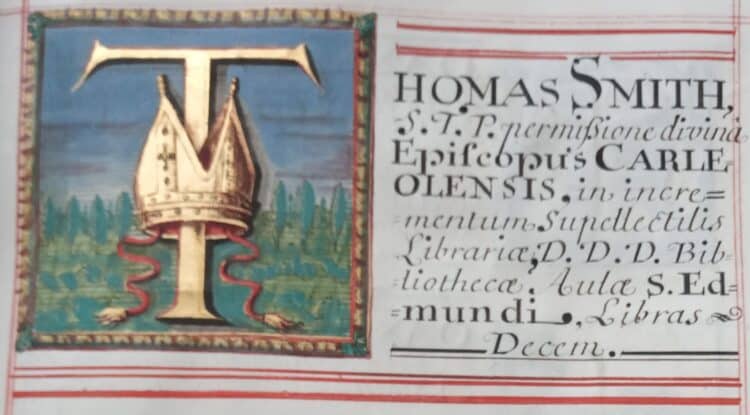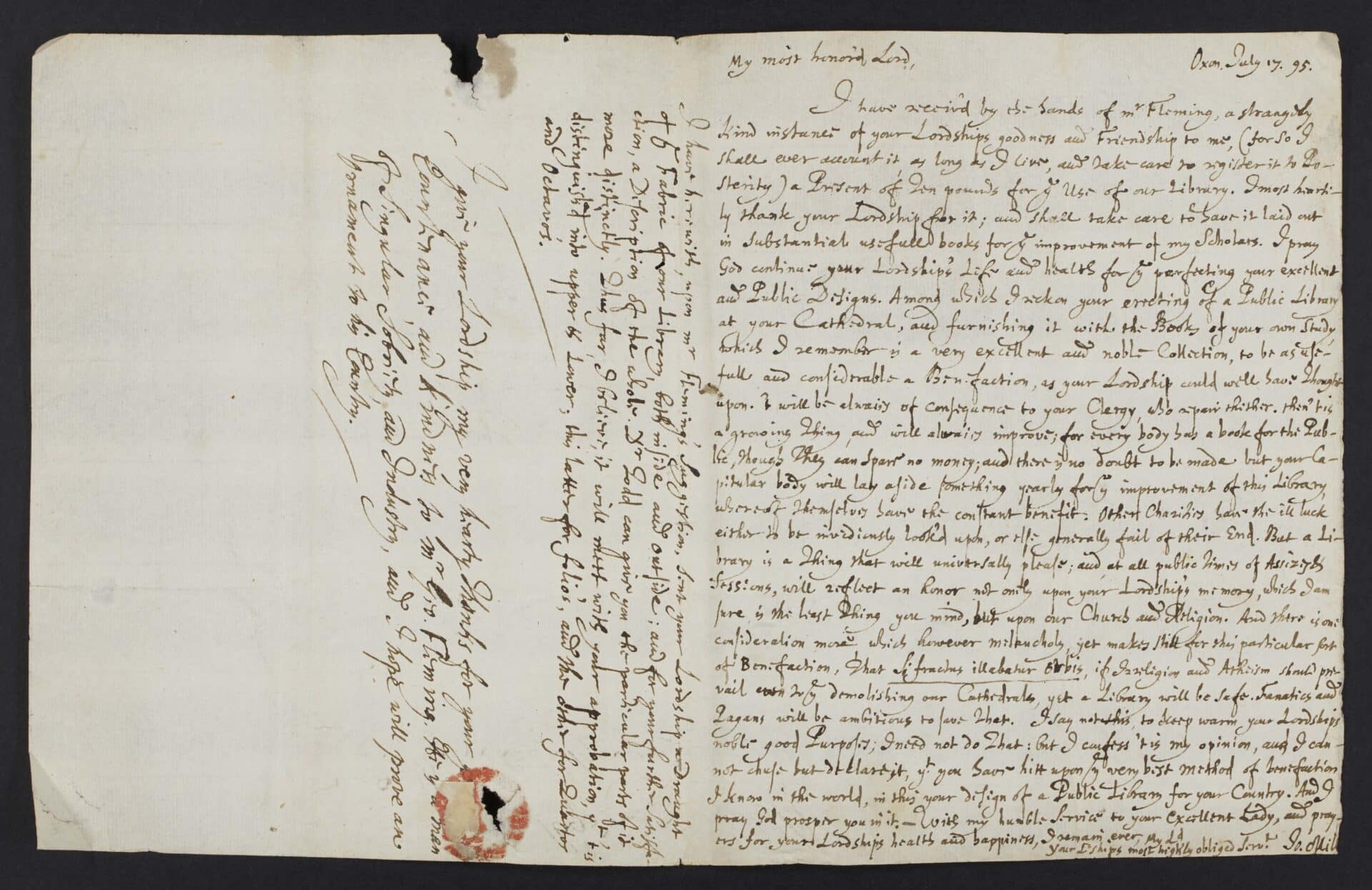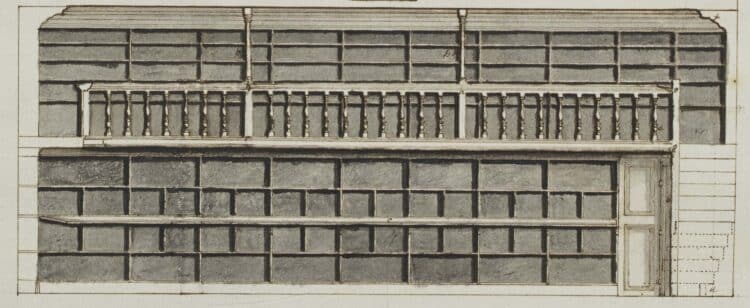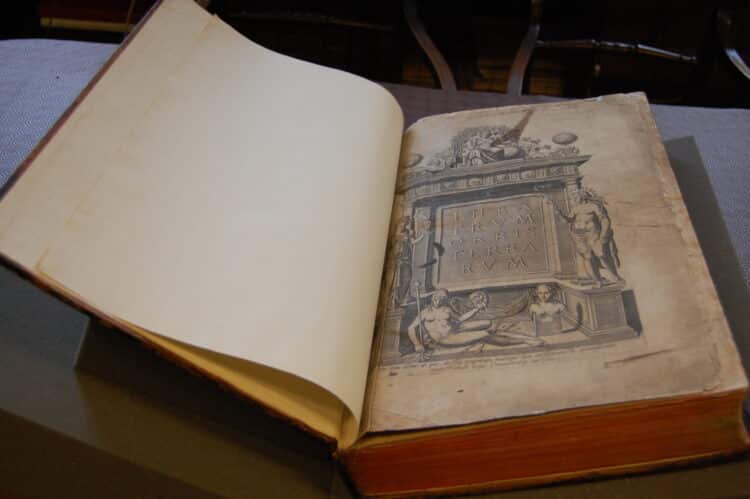“A Library is a thing that will universally please”: The donations of Thomas Smith, Bishop of Carlisle and the earliest image of the Old Library
28 Feb 2024|James Howarth
- Library, Arts & Archives

A beautiful illuminated entry in the Hall’s Benefactor’s book records the gift of £10 to the Library by Thomas Smith (1615-1702). Smith was Bishop of Carlisle from 1684-1702 and the gilded ‘T’ of his first name is appropriately decorated with a mitre in his entry. Smith had been a Fellow of Queen’s before the Civil War. Until recently, we knew the gift was likely to have been given sometime in 1695 during the tenure of Principal John Mill, but not much else.
But then Rob Petre, our Archivist, was contacted by the Cumbria Record Office, who had discovered a letter from Mill to Smith, thanking him for his gift. This has shed light on the precise circumstances of the donation as well as providing the earliest surviving description, and more excitingly illustration, of the Old Library.
“A strangely kind instance of your Lordships goodness”: The Letter
The Letter, as was common in the 17th century, consists of a single sheet of paper folded so that when sealed it created an envelope which could be addressed to the recipient.
Mill’s letter, dated 17 July 1695, takes up the right half of the ‘inside’ of the sheet with two, more-hastily written, postscripts at right angles on the left.
Folded into the letter are two single sheets with drawings of the Old Library and the Chapel alongside a short description and illustrations of the fittings.

Mill’s thanks for the donation are expressed in lavish terms: the gift is a “…strangely kind instance of your Lordships goodness and Friendship to me, (for so I shall ever account it, as long as I live, and take care to register it to Posterity)” and he prays that “God continue your Lordship’s Life and health for ye perfecting your excellent and Public Designs.”
Fittingly in response to a gift to the Hall Library, Mill focuses on the Bishop’s own project to build a new Cathedral Library in Carlisle, which had recently been completed in 1691. This is, Mill says, “as useful and considerable a Benefaction, as your Lordship could have thought upon” and “the best method of benefaction I know in the world.”
In his praise he makes several points. One thought, that the Library will be a “growing thing and will always improve” as members of the Cathedral Chapter will donate books and also that it is easier to convince people to give books over money (“for every body has a book for the Public, though they can spare no money”), is notable in terms of the way the Hall’s own Library mostly grew from Aularian donations. Mill also stresses the importance of the establishment of the Library as a public good and mark of distinguishment for the Cathedral: “a Library is a thing that will universally please; and at all public times of Assizes & Sessions, will reflect an honor not only upon your Lordships memory, which I am sure is the least thing you mind, but upon our Church and Religion.” Again, it is interesting to consider this alongside the motives of Stephen Penton in the construction of Hall’s Chapel and Library which were completed under Mill. The last sentiment of praise in the letter is perhaps more unfortunate. Mill enthuses that even “if Irreligion and Atheism should prevail even to ye demolishing our Cathedrals, yet a Library will be safe. Fanatics and Pagans will be ambitious to save that.” As the medieval Cathedral Library had been destroyed by Parliamentary forces during the Civil War, this is, to say the least, tactless.

“a Draught of ye Fabric of our Library “: Illustrating the Old Library
At first glance the drawing of the Old Library seems to show a view familiar to us today. There are noticeable differences though. The building itself is much smaller, as when the Chapel and Library were built the last quarter of the frontage was merely a façade with false brick windows covering a portion of New College’s garden behind. Notably this is not evident at all in the sketch of the frontage, although it is in the floor plan which shows the truncated space just after the third window bay. The patch of ground in New College was not acquired until 1931, when Principal Emden extended the Old Library to its current dimensions.

The Library gallery is also shorter than the current incarnation, being only on the east wall rather than all the way round. It was extended twice: once in the 19th century in a rather mysterious renovation about which we know very little (information only survives in the form an early 1900s photograph), then again in 1931. The design of the balustrade and columns, originally by a carpenter called Arthur Frogley in the 1680s, survives, however. The Old Library was the first college Library in Oxford to have a gallery, which may be why it forms the largest section of Mill’s description.
Perhaps the biggest difference between the Library of 1695 and today is the existence of a long table shelf along the length of the ground floor shelves, “In the middle is fix’d a reading desk, quite round.” Is Mill’s rather strange description.
This is to allow easy reading of the books which were chained to the bookshelves. An arrangement that can still be seen in, for example, the chained library at Hereford Cathedral. The earliest surviving records of payments for book chains for the Hall Library date from 1697 in the New Ledger Book.
Also in 1697, when Thomas Hearne compiled the first catalogues of the Old Library, the collection contained around 500 volumes, divided roughly 50-50 between large folio volumes and smaller quartos and octavos. We still hold the vast majority of these items and they are currently shelved in the same sequence of shelf marks as they were in the 1690s (another part of Emden’s re-organisation of 1931). Currently all of these books are on the lower floor shelves, however originally the large books were downstairs and the smaller in the gallery: “The lower part… contains only folio’s…There are five rowes of Shelves in the Gallery, which are designed for Quarto’s and Octavo’s”. As the drawing shows eight bays of shelves in the lower floor and ten in the gallery, one cannot help thinking that the shelves must have been rather bare.
“Substantial useful books for ye improvement of my Scholars”: The Donation
In his letter to the Bishop of Carlisle, Mill promises that he “shall take care to have it [the £10 donation] laid out in Substantial useful books for ye improvement of my Scholars.”
Thanks to inscriptions in some of the books and information in the catalogues prepared by Thomas Hearne we know that the money was used to purchase nine volumes, eight of which remain in the Library.

One of the items Mill acquired is amongst the finest works in the Old Library: Abraham Ortelius’ Theatrum orbis terrarium (The theatre of the world). The Theatrum is often considered the first modern atlas and was immensely successful, being published in 31 editions between 1570 and 1612. The number of maps included grew from 53 to 167. The edition we hold was the first to include detailed maps of Papua New Guinea, the Soloman Islands and Chesapeake Bay
It also includes the earliest printed European map of China, first published by Ortelius in 1584. Unusually it is oriented West-East not North-South. The atlas, an outsize folio, would have been an expensive purchase at the time and remains the most valuable book in the collection.
The biggest grouping of books purchased are ‘classics’: fundamental works of Greek and Latin literature. These include a brand-new edition of Thucydides’ History of the Peloponnesian War published in January 1696 (which also shows the money was not spent immediately on arrival in Oxford).
Not all of the books were recent publications, there were two editions with commentary of the poet Horace from the 1579 and 1594. Notably Horace was on Mill’s mind when he wrote to Smith, he quotes from one of the poet’s Odes, “Si fractus illabatur orbis…” [“if the world should brake and fall”], when he imagines the survival of the Cathedral Library against all obstacles.
There is also a three-volume edition of Virgil from 1647 purchased for the relative bargain price of £1 16 shillings.
Scientific works are also represented by two volumes, De motu animalium [On the Motion of Animals] and De vi Percussionis, et Motionibus Naturalibus a Gravitate Pendentibus [‘Of the Force of Percussion, and of Natural Motions Dependent on Gravitation] by the Italian natural philosopher Giovanni Borelli who has been called the father of modern biomechanics. Each features many plates illustrating the scientific propositions of the works. De Motu animalium also has a fragment of beautifully written paper tab which would have shown the title and shelf mark of the book when it was stored with the foredge facing out rather than the spine to front (as was the practice when the Old Library was built).
The missing item is one of the copies of Horace. Its fate is uncertain, it appears in all three catalogues compiled by Hearne around 1697 as well as the annotated copy of the printed 1674 Bodleian catalogue that was used as a working catalogue of the Old Library, but has disappeared in the next catalogue which was made in 1774. From the recorded details we know the book was printed by Christophe Plantin in Antwerp in 1579.

Do these nine books amount to ten pounds of spending? Larger numbers of books were acquired using the £10 donations of Francis Cherry (15 volumes) and Henry Partridge (21 volumes) which were also given in the 1690s. We have noted before that Thomas Hearne suspected Mill of sharp practise in his use of book donation money. Slightly over £1 a volume seems suspiciously high especially as all three volumes of Virgil were only £1 16 shillings.
There exists though evidence that could exonerate Mill a little. Ten pounds sent from Carlisle in the may not have been worth ten pounds in Oxford in the 1690s. Letters sent by Hall Student George Fleming (mat. 1688) to his father contain consistent complaints is that, due to the quality of the coinage, money sent from Cumbria is not accepted at face value in the south. For example, he writes to his Father on 16 July 1695, the day before Mill’s letter to Smith, “The five Pounds Tom brought me of my own, proves so bad ; as I am in fear it will not go off, even in Oxford.”As it happens the closeness of the dates of these two letters – Fleming’s to his father and the Principal of the Hall to the Bishop of Carlisle – is not a coincidence. As we will see in the second part of this series, It is from the surviving correspondence of the Fleming family that we can deduce the context and circumstances that spurred Smith’s generous donation to the Hall.
To be continued…
Category: Library, Arts & Archives
Author

James
Howarth
James has been St Edmund Hall’s Librarian since May 2018. He is responsible for maintaining and developing the library’s collections – including the historic and special collections that are housed in the seventeenth-century Old Library and is keen to promote their use in research, study and outreach.